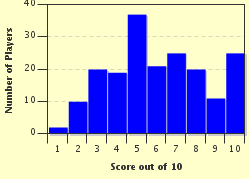Quiz Answer Key and Fun Facts
1. Before there was anything, according to Egyptian mythology, there was an endless expanse of water. What name was given to these primordial waters and the being who personified them?
2. From the expansive waters which were said to predate everything in Egyptian mythology came an egg. From this perfectly spherical egg came Re (or Ra). Which celestial body is most associated with Re?
3. Re, like many other gods in Egyptian mythology, was often linked to other deities/given alternative names. One of these alternatives was Atum, who represented an aging and dying god. Another was Khepri, who represented rebirth. Which animal is most closely linked with Khepri?
4. Re was also a creator god, and he formed two children, whom he named Shu and Tefnut. Which of the following is most associated with these two deities?
5. One myth tells us of how Re once lost his children, Shu and Tefnut, after they fell into the water which surrounded them. After finding his beloved offspring, Re wept tears of joy. What did these tears become?
6. Shu and Tefnut performed the first act of sexual reproduction in Egyptian mythology, giving birth to Geb (the earth) and Nut (the sky). One major trait of Geb was his loud laugh, which earned him the nickname of "the Cackler". What natural phenomenon was the laughter of Geb said to cause?
7. One myth of ancient Egypt tells of how Geb and Nut had to be physically separated by their father (Shu) after Nut ate their children. Which of the following was said to represent these children?
8. Just as the primordial waters of ancient Egyptian mythology gave life to the gods, water (in the form of the river Nile) was essential to the lives of the humans who lived in Egypt. Which god is personified by the river Nile?
9. The lives of the gods and humans in Egyptian mythology were said to be based around Ma'at, the balance of life. Perhaps the greatest threat to this order was the giant serpent which was believed to attack the sun each night. What name was given to this serpent?
10. The idea of death and resurrection is a central theme in Egyptian mythology. What name is given to the Egyptian underworld?
Source: Author
doublemm
This quiz was reviewed by FunTrivia editor
looney_tunes before going online.
Any errors found in FunTrivia content are routinely corrected through our feedback system.


